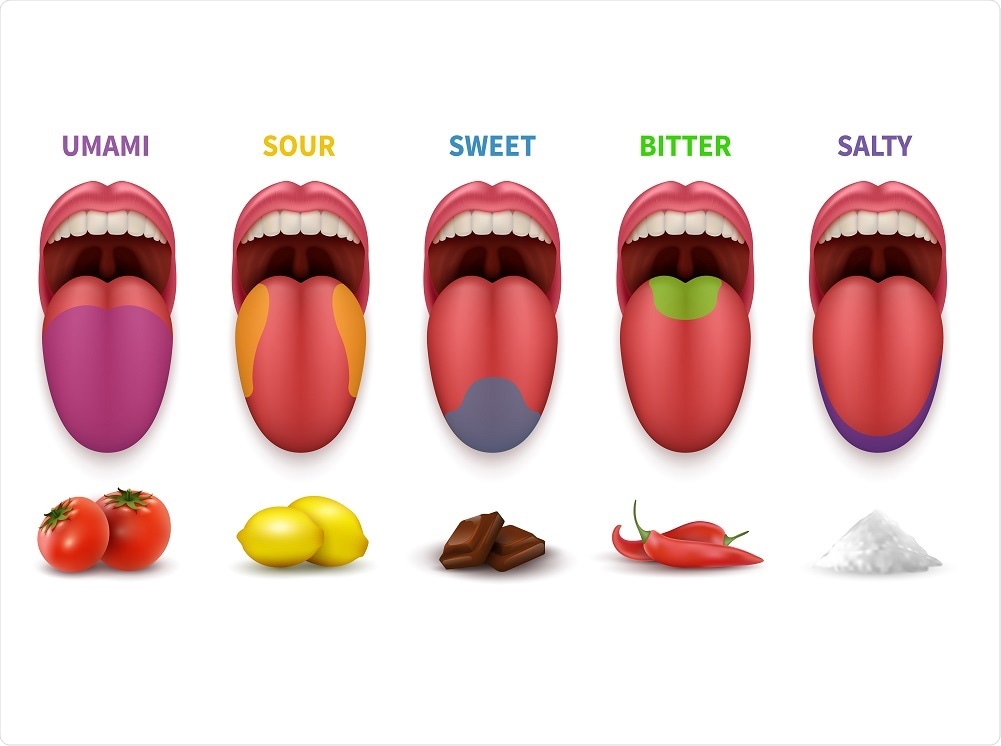Taste is a key factor in determining which food and drink items consumers buy.

Image Credit: MicroOne/Shutterstock.com
From a consumer’s point of view, taste describes flavor, which also involves olfactory or smell mechanisms and chemesthetic sensations such as warming. For those involved in food research, taste refers to sweetness, sourness, bitterness, saltiness, and umami sensations.
The perception of taste and flavor influences dietary choices and therefore nutrition, health, and even the risk of lifestyle disorders.
Consumers have become increasingly interested in what is referred to as “personalized foods,” a trend characterized by individual preferences in terms of not only taste but in terms of convenience, packaging, and expense.
Knowledge about the genetic variations in chemosensory receptors could help inform the development of personalized foods by manufacturers and healthcare professionals.
The genetic element
Taste and flavor perception differ between individuals partly due to inborn genetic variations in the multiple taste receptors found in the mouth and in the gut where they are involved in nutrient sensing. Genetic variants including single nucleotide polymorphisms (SNPs) and copy number variants (CNVs) influence gene expression and function but in taste research, SNPs are most explored.
Now, in a paper recently published in Annual Reviews, Alissa Nolden from the University of Massachusetts and Emma Feeney from University College Dublin have provided a comprehensive overview of the association between taste genetics and food perception and choices.
The five main taste sensations
They initially discuss bitterness, before moving onto the other taste sensations, namely sweetness sourness, saltiness, and umami. They also refer to the receptors involved in the chemesthetic sensations that mediate perception of pain, touch, warmth, and cooling, for example.
Of the five main taste sensation, bitterness, the authors say, is the one with the most genes coding for taste receptors and family of receptors has received the most attention in taste genetic research investigating food perception, choice, and intake.
More than one thousand receptors involved in bitterness have been identified to date and the researchers say more will probably be discovered and that future research will help establish the degree to which genes involved in bitterness influence people’s decisions to consume healthy foods such as certain antioxidant-rich vegetables.
In their discussion of sweetness, the team reports that three genes in the human taste receptor type 1 (TAS1R) family code for receptor subunits that join in pairs to form umami receptors and sweet receptors.
Two SNPs identified in the TAS1R family have been reported to account for some of the variability in sucrose detection, while one has been implicated in the perception of sweetness and sucrose intake and another was found to be associated with dental caries prevalence.
It is thought that differences in receptor function result in varied sensitivity to sweet sensations and therefore may be predictive of sweet food consumption leading to poor dental health, although this is not yet a confirmed mechanistic link,”
Polymorphisms in this family have also been linked to changes in Umami sensations, total fat intake and intake of savory and protein-rich foods.
“As TAS1R1 is a shared subunit with the sweet taste receptor, these observations for fat intake could stem from differences in sweet perception for highly palatable foods (i.e., foods high in fat and high in sugar); although more work is needed to uncover the role of TAS1R1 in fat taste perception,” explains the team.
The authors say studies have investigated genetic factors associated with sourness but that, currently, there is no evidence to support this relationship.
In their discussion of salt, the reviewers say polymorphisms in the sodium channel (SCNN1) gene family, which codes for the subunits that form a sodium-selective ion channel, have been associated with variations insensitivity to and intensity ratings of salt.
Chemosthetic sensations
Unlike taste, which is perceived in the oral cavity, chemosthetic sensations are perceived throughout the body and are transduced via different nerves than those involved in taste.
The receptors that mediate responses to chemical stimuli in foods and drink are coded for by genes in the transient receptor potential (TRP) superfamily.
The reviewers say a polymorphism in the subfamily V member - TRPV1 - has been reported to cause variation in burning sensation on ethanol intake: “This work suggests that the sensory profile of alcoholic beverages differs between individuals as a result of ethanol perception.”
Potential areas for improvement
Nolden and Feeney say that there has been a great deal of research into genetic variation in taste receptors, particularly in the perception of bitterness, but that that research into the field of chemesthetic sensations is still relatively new.
Studies that examine taste perception and food intake are also often confounded by multiple factors, the authors add, including a lack of standardized taste perception measures as well as gender, socioeconomic and cultural differences between populations.
“To address these issues, longitudinal, cross-cultural studies that use standardized, age-appropriate methods of taste perception and dietary intake measures are needed,” write the researchers.
These studies may provide insight into how genetic differences in taste affect preferences, intake, and health over the life span, how to identify individuals at risk of development of detrimental dietary, and whether these differences are more evident during first exposures.”
Commenting on the growing interest in personalized foods, the team concludes that this “offers opportunities to integrate individual sensory perceptions into various stages of food product development, thus improving ingredient selection to formulate products that meet both individual preferences and desired nutrient profiles.”
Journal references:
Nolden A and Feeney E. Genetic Differences in Taste Receptors: Implications for the Food Industry. Annual Review of Food Science and Technology 2020;11 https://doi.org/10.1146/annurev-food-032519-051653
Ghosh D. Personalised food: how personal is it? Genes & Nutrition 2010;5(1):51–53. DOI:10.1007/s12263-009-0139-0